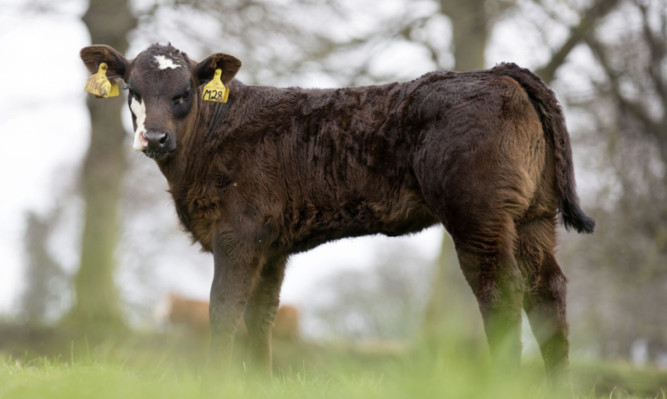Ease of calving and the opportunity to earn a premium price from heifers’ calves are just two of the benefits of using an Aberdeen-Angus sire, according to Alisdair Hopkinson of Lindertis Farms at Kirriemuir.
Having previously used a Continental sire on heifers with all progeny slaughtered, Alisdair, who manages the herd alongside his son Thomas, says using an Angus sire allows heifers to be retained as replacements, while male calves are steered and can be sold off grass at a premium price at about 18 months old.
“The herd is largely based on Simmental genetics, with both Aberdeen-Angus and Simmental sires used across the herd, but an Angus bull is used exclusively across the heifers and to serve the later-calving cows.
“This system works well and means we have a decent sized batch of Aberdeen-Angus cross calves coming through the system as well as Continental-sired cattle, allowing us to spread the sale period and hence balance the cash flow from the 175-cow herd through the year,” he said.
“We don’t regimentally put cows back to a bull of a different breed to their father, but instead every cow is put to a bull depending on her individual merits.
“Equally, replacement heifers are also picked according to their merits, with the only criteria being that they are born in the first 24 days of calving to maximise fertility.
“To aid fertility and reduce problems, cows which have had difficult calvings are also put to the Angus sire to ease calving next time around,” says Alisdair.
“Fertility is hugely important to us, and this year we achieved a calving percentage of 89 calves sold for every 100 cows put to the bull.
“We’re aiming for something above 90%, but it’s taking some work to get there, with health and diet playing a central role.
“Cows are routinely tested for Johne’s and vaccinated for both BVD and leptospirosis to minimise the chances of disease causing cows to be barren.
“We also semen test all bulls prior to use, and on top of that we work closely with our nutritionist, Nick Canning at East Coast Viners, to ensure cow diets promote fertility.”
Historically the herd has suffered with sub-clinical endometritis, but changes to cow rations and better use of minerals in the diet have overcome those problems and helped improve fertility.
“We’re now calving about 75% of the herd in the first four weeks of calving,” adds Thomas.
Ease of calving is essential in a large-herd situation, and he says bulls are actively selected for ease of calving when looking at bulls’ Estimated Breeding Values prior to purchase.
“We also pay close attention to both health status and performance figures to ensure they’ll suit our system.”
Finishing the Aberdeen-Angus crosses at grass in their second summer means he looks closely at 600-day weights, too.
The herd is all spring calving, with heifers calved at two years old and calved a week or so ahead of the main herd starting.
The main herd starts calving on March 1, with all cows out-wintered on swedes and kale until late December or early January, depending on the year, said Alisdair.
“Then cows are housed in four groups according to condition score, with a group of older leaner cows, a group of older fit cows, a group of younger leaner cows and a group of younger fit cows.”
“Having cows in the right condition at calving is vital, particularly as cows spend the summer on upland grazing. They need to go to the summer grazing in the right condition to milk well and grow calves prior to weaning in the autumn.”
Alisdair feels another bonus to the system is that retained Aberdeen-Angus cross cows are great at retaining their condition and put flesh on quickly.
“The same is true of the Aberdeen-Angus cross finishing cattle, and they run on permanent pasture for their second summer with a 12% protein, 14 ME, finishing ration offered via a hopper for the last couple of months of the finishing period to add a quality finish to them prior to slaughter.
“All our cattle are sold deadweight to Scotbeef at Bridge of Allan, with the first Angus cross steers sold at about 18 months old and all of the Angus crosses sold by the time they’re 22 months old.
“The Aberdeen-Angus premium makes them much more worthwhile and prompted the switch to Angus bulls about nine years ago.”
Alisdair is achieving heifer carcase weights of about 310kg, with steers averaging 350-355kg and most carcases grading as U and R grades.
“They’re good carcases and the Angus crosses are quick to finish once you’ve grown the frame on them.”
With the farm also growing about 950 acres of arable crops including wheat, barley, oats and oilseed rape, as well as 25 acres of raspberries Alisdair says the aim with the cattle enterprise is to add value to the upland areas of the farm.
“The cattle have to pay their way or they wouldn’t be here, but equally we have upland/hill grazing which is never going to be suited to arable crops, so we have to maximise the value of the output from that ground.
“High-quality suckler-bred beef is a good way of converting that grassland to a valuable crop and means that we have manure to go back into the arable rotation, which allows us to feed some of our own cereal crops and add value to them in poorer years,” he added.
